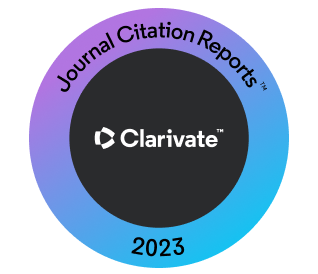Physicochemical Quality and Genotoxic Potential of Wastewater Generated by Canteen Complex
Abstract
Canteens generate high volumes of wastewater that should constantly be subjected to physicochemical and genotoxicity screening. In this study, the wastewater generated by a canteen complex was screened for physicochemical properties and genotoxic potential using standard procedures and Allium cepa chromosome assay. Results showed that the wastewater had total suspended solids, total dissolved solids, and total hardness concentrations of 120.70 mg/l, 554.50 mg/l, and 500.00 mg/l, respectively. The chloride concentration of the wastewater (7873.60 mg/l) was much higher than the recommended limit of 250 mg/l. The wastewater inhibited root growth in A. cepa at 0.1%, 1%, 10%, 25%, 50%, and 100% concentrations but promoted root growth at 2% and 5% concentrations. The wastewater was highly mitodepressive, with mitotic inhibition generally increasing with rising concentrations. The major chromosomal aberrations observed in A. cepa exposed to different concentrations of canteen wastewater were vagrant, sticky, and bridged chromosomes. No chromosomal aberration was observed in onion roots exposed to water (control). The differences in total chromosomal aberrations across wastewater concentrations were not statistically significant (P > 0.05). In view of these results, the practice of discharging untreated canteen wastewater into drainage canals may not be environmentally sustainable.
Downloads
References
Adegbite, A.E., and Olorode, O., 2002. Karyotype studies of three species of Aspilia thouar (Heliantheae-Asteraceae) in Nigeria. Plant Science Research Communication, 3, pp.11-26.
American Public Health Association, APHA, 1998. American Standard Methods for Examinations of Water and Wastewater. 19th ed. American Public Health Association (APHA)-American Water Works Association (AWWA)-American Pollution Control Federaation (WPCF), Washinghton, DC.
Chen, X., Chen, G., and Yue, P.O., 2000. Separation of pollutants from restaurant wastewater by electrocoagulation. Separation Purification Technique, 19, pp.65-76.
Dada, E.O., Akanni, A.R., and Akinola, M.O., 2017. Comparative physico-chemical and genotoxicity assessments of textile mill company effluent and local Tie-and-Dye textile wastewater. Journal of Applied Science and Environmental Management, 21(5), pp.877-882.
Dada, E.O., Akinola, M.O., and Haruna, R., 2018. Physico-chemical and genotoxicity assessments of palm oil mill effluent generated by a corporate refinery in Nigeria. Pollution, 4(1), pp.83-92.
Davies, B., Lockwood, A., and Stone, S., 1998. Food and Beverage Management. 3rd ed. Butterworth-Heinemann, Oxford.
Feretti, D., Zerbini, I., Zani, C., Ceretti, E., Moretti, M., and Monarca, S., 2007. Allium cepa chromosome aberration and micronucleus tests applied to study genotoxicity of extracts from pesticide-treated vegetables and grapes. Food Additives and Contaminants, 6, pp.561-572.
Fiskesjo, G., 1985. Allium test on river water from bran and sexan before and after closure of a chemical factory. Ambiologia, 14, pp.99-103.
Fusi, A., Guidetti, R., and Azapagic, A., 2016. Evaluation of environmental impacts in the catering sector: The case study of pasta. Journal of Cleaner Production, 132, pp.146-160.
Kaymak, F., and Goc-Rasgele, P., 2009. Genotoxic effects of raxil on root tips and anthers of Allium cepa L. Caryologia, 62(1), p.1-9.
Klasterska, I., Natrajan, A.T., and Ramel, C., 1976. An investigation of the origin of chromatid aberrations and chromosome stickiness as a category of chromatid aberrations. Hereditas, 83, p.153.
Kuras, L., 2004. Characterization of protein–DNA association in vivo by chromatin immunoprecipitation. In: Dickson, R.C., and Mendenhall, M.D., editors. Signal Transduction Protocols, Methods in Molecular Biology. Humana Press, Totowa, pp.147-162.
Leme, D.M., and Marin-Morales, M.A., 2009. Allium cepa test in environmental monitoring: А review on its application. Mutation Research/Reviews in Mutation Research, 682, pp.71-81.
Mahmood, S., and Maqbool, A., 2006. Impacts of wastewater irrigation on water quality and on the health of local community in Faisalabad. Pakistan Journal of Water Resources, 10, pp.230-270.
Metin, M., and Burun, B., 2008. Cytogenetic effects of Urginea maritima L. Aqueous extracts on the choromosomes by using allium test method. Caryologia, 61(4), pp.342-348.
Mohamed, R.M.S., Apandi, N.M., Peralta, H.M.M., and Kasim, A.H.M., 2015. Removal of nutrients from cafeteria wastewater using varying concentrations of microalga Scenedesmus sp. Proceedia Environmental Sciences, 2015, pp.2-6.
Olorunfemi, D.I., Ogieseri, U.M., and Akinboro, A., 2011. Genotoxicity screening of industrial effluents using onion bulbs (Allium cepa L.). Journal of Applied Science and Environmental Management, 15(1), pp.211-216.
Rainwater, K., 2004. Review of Systems for Restaurant Wastewater Pre- Treatment. Paper Submitted to Texas On site Wastewater Treatment Research Council, Austin, Texas.
Yasin, Z.A.M., Mahmood, M., and Shaharudiin, N.A., 2017. Effects of micronutrients (Cu, Zn, Mn, and Fe) on the growth of spathoglottis plicata plantlets. Journal of Biotechnology, Computational Biology and Bionanotechnology, 98(1), pp.5-13.
Ying, L., Li-Kun, Y., and Jing, Z., 2011. Study the way to forecast the discharge of restaurant wastewater in Beijing. Proceedia Environmental Sciences, 11, pp.850-857.
Copyright (c) 2019 Ebenezer O. Dada, Chioma M. Agu, Modupe O. Akinola

This work is licensed under a Creative Commons Attribution-NonCommercial-ShareAlike 4.0 International License.
Authors who choose to publish their work with Aro agree to the following terms:
-
Authors retain the copyright to their work and grant the journal the right of first publication. The work is simultaneously licensed under a Creative Commons Attribution License [CC BY-NC-SA 4.0]. This license allows others to share the work with an acknowledgement of the work's authorship and initial publication in this journal.
-
Authors have the freedom to enter into separate agreements for the non-exclusive distribution of the journal's published version of the work. This includes options such as posting it to an institutional repository or publishing it in a book, as long as proper acknowledgement is given to its initial publication in this journal.
-
Authors are encouraged to share and post their work online, including in institutional repositories or on their personal websites, both prior to and during the submission process. This practice can lead to productive exchanges and increase the visibility and citation of the published work.
By agreeing to these terms, authors acknowledge the importance of open access and the benefits it brings to the scholarly community.














 ARO Journal: A Scientific Periodical Open Access Journal and has no APC & ASC.
ARO Journal: A Scientific Periodical Open Access Journal and has no APC & ASC.